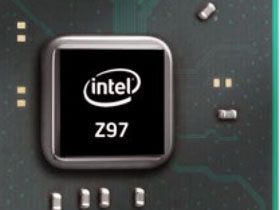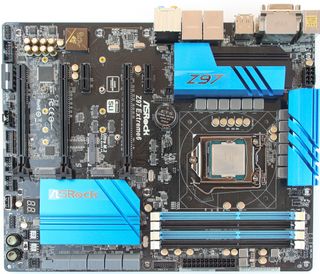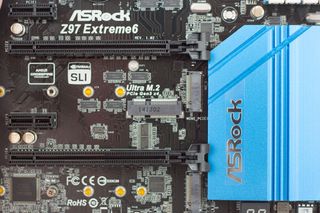A 1400 MB/s SSD: ASRock's Z97 Extreme6 And Samsung's XP941
Z97 ushers in new and exciting ways to attach and use storage devices. With support for M.2 PCIe and SATA Express, two sides of the same SSD coin, Z97 improves on Z87. But not everywhere. AsRock add to Z97 with some new tricks, and so we take a look.

High-Performance Storage On ASRock's Z97 Extreme6
When the Advanced Host Controller Interface was standardized a decade ago, it was built around mechanical storage. In truth, it did an admirable job replacing the moribund IDE standard that preceded it. And even as SSDs came into their own, this programming interface to SATA was still good enough. At least at first.
Today, it’s holding SSDs back. Solid-state storage doesn’t need to exist in the same form factors as mechanical storage, nor does it need the same kind of programming interface. Intel's Z97 Express platform controller hub, which Thomas covered for the first time in Intel Z97 Express: Five Enthusiast Motherboards, $120 To $160, gives us the newest example of enabling SSDs in many shapes and sizes. It takes us away from a vestigial SATA/AHCI ecosystem to a new place where PCIe and SATA Express create an even clearer distinction between mechanical and solid-state storage.
As you start seeing more M.2 PCIe- and SATA Express-equipped boards, think future-ready. Neither plug will do you a ton of good initially. But they pave the way for a new world of storage on the desktop and in mobile applications. You get SATA ports for legacy devices, and the newer interfaces for the latest SSDs. At some point in the future, we'll get to a place where we can forgo AHCI altogether, and instead reap the benefits of solid-state storage through AHCI’s replacement, NVMe.
Meet ASRock's Z97 Extreme6
Serving as our spirit guide through this uncharted landscape is ASRock’s Z97 Extreme6. Thomas wasn't particularly bowled over by Z97's evolutionary changes. But I couldn't help but wonder whether the chipset enables storage nirvana (there isn't much to differentiate Z97 from Z87, after all).

The Z97 Extreme6 is one of ASRock's higher-end models with support for multi-GPU configurations, premium audio, and overclocking. But my interests in it are specific to the platform's storage capabilities.

The board exposes 10 SATA 6Gb/s ports. Six are native to Intel's Z97 Express PCH, while four attach to a pair of ASMedia ASM1061 controllers. One port connects to an eSATA interface on the rear panel, also.
That SATA Express connector is shared with two SATA ports and the M.2 socket. As you'll see, Intel's drive to push innovation in the storage space on mainstream core logic causes some of the same traffic jams we're accustomed to describing on the graphics side (shared PCI Express lanes and all of that).
Stay on the Cutting Edge
Join the experts who read Tom's Hardware for the inside track on enthusiast PC tech news — and have for over 25 years. We'll send breaking news and in-depth reviews of CPUs, GPUs, AI, maker hardware and more straight to your inbox.

Surprisingly, perhaps, even though SATA Express is brand new, that's not the big feature here. Rather, it's the Ultra M.2 x4 socket. Wired not through the PCH (like the standard M.2 interface on Z97's ports 13 and 14, along with SATA Express), it isn't subject to the same limitations. It instead utilizes four lanes of PCI Express 3.0 siphoned off of the CPU, yielding up to 32 Gb/s of bandwidth. And while you'll never get 4 GB/s out of it, the right SSD could make for a special evening of benchmarking.
And wouldn't you know it? We have Samsung's XP941, an OEM-oriented drive, for testing. It uses four PCI Express lanes and comes equipped with the hardware to match. That'll allow us to determine if Intel's Z97 Express and ASRock's Z97 Extreme6 come together to make storage dreams come true.

Current page: High-Performance Storage On ASRock's Z97 Extreme6
Next Page M.2 And SATA Express, Discussed-
aminebouhafs Once an SSD in plugged into the Ultra M.2 slot, the bandwidth between central processing unit and graphics processing unit is cut-down by half. Therefore, while the end-user gets additional SSD performance, the end-user may lose some GPU performance because of insufficient bandwidth between it and the CPU.Reply -
JoeArchitect Very interesting article and a great read. Thanks, Chris - I hope to see more like this soon!Reply -
Eggz This makes me excited for X99! With 40 (or more) lanes, of PCI-e (probably more), there will be no need to compromise. We have to remember that the Z97 Chipset is a consumer-grade product, so there almost has to be tradoffs in order to justify stepping up to a high-end platform.Reply
That said, I feel like X99, NVMe, and and M.2 products will coincide nicely with their respective releases dates. Another interesting piece to the puzzle will be DDR4. Will the new storage technology and next-generation CPUs utilize it's speed, or like DD3, will it take several generations for other technologies to catch up to RAM speeds? This is quite an interesting time :) -
Amdlova Chris test the asrock z97 itx... and another thing... my last 3 motherboard from asrock and i want to say Asrock Rock's!Reply -
Damn_Rookie While storage isn't the most important area of computer hardware for me, I always enjoy reading Christopher's articles. Very well written, detail orientated, and above all else, interesting. Thanks!Reply -
hotwire_downunder ASRock has come along way, I used them a long time back with disappointing results, but I have started to use them again and have not been disappointed this time around.Reply
Way to turn things around ASRock! Cheap as chips and rock steady! -
alidan @aminebouhafs if i remember right, didn't toms show how much performance loss there is when you tape gpu cards to emulate having half or even a quarter of the bandwidth? if i remember right back than the difference was only about 12% from 16 lanes down to either 4 or 8Reply -
Eggz Reply13445787 said:@aminebouhafs if i remember right, didn't toms show how much performance loss there is when you tape gpu cards to emulate having half or even a quarter of the bandwidth? if i remember right back than the difference was only about 12% from 16 lanes down to either 4 or 8
PCI-e 3.0 x8 has enough bandwidth for any single card. The only downside to using PCI-e lanes on the SSD applies only to people who want to use multiple GPUs.
Still, though, this is just the mid-range platform anyway. People looking for lots of expansion end up buying the X chipsets rather than the Z chipsets because of the greater expandability. I feel like the complaint is really misplaced for Z chipsets, since they only have 16 PCI-e lanes to begin with. -
cryan ReplyOnce an SSD in plugged into the Ultra M.2 slot, the bandwidth between central processing unit and graphics processing unit is cut-down by half. Therefore, while the end-user gets additional SSD performance, the end-user may lose some GPU performance because of insufficient bandwidth between it and the CPU.
Well, it'll definitely negate some GPU configurations, same as any PCIe add-in over the CPU's lanes. With so few lanes to work with on Intel's mainstream platforms, butting heads is inevitable.
Regards,
Christopher Ryan
Most Popular

